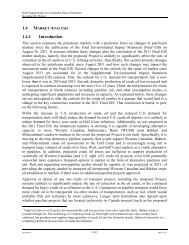year, 4 although the substitution of more abundant petroleum products for coal in parts of theworld that use both fuels may result in some offsetting reductions in CO 2 emissions.ConclusionsOne of the most contentious issues in the debate about whether the crude oil export ban shouldbe lifted is how US gasoline prices will be affected. Commenters span the full range from findingthat gasoline prices will increase, decrease, and remain unchanged. In this issue brief, we offereconomic logic and estimates from our modeling and data analysis suggesting that the price ofgasoline will likely fall by around three to seven cents a gallon. These results are driven by theincrease in refinery efficiency made possible by lifting the ban and from a nuanced considerationof OPEC behavior. Indeed, Box 1 presents sensitivity analyses showing that falling gasoline pricesare quite robust to alternative assumptions about demand and supply elasticities, as well asassumed refinery cost reductions. Even with more equivocal results, we believe that theeconomic arguments for lifting the ban are strong, based primarily on the gains from free tradeand the example it sets when we live by our market principles. Such action will create winners andlosers, however, and may lead to increases in greenhouse gases.………………………………….4 On average, every barrel of oil refined and combusted generates 8.4 Mcf (Van’t Veld et al, 2013). Theconversion between Mcf and tonnes is not constant – it depends on things like atmospheric pressure – but areasonable rule of thumb is 19.25 Mcf per tonne.10 B R O W N E T A L . | R E S O U R C E S F O R T H E F U T U R E
ReferencesAllaire, Maura, and Stephen P.A. Brown. 2012. US Energy Subsidies: Effects on Energy Markets andCarbon Dioxide Emissions. Washington, DC: Pew Charitable Trusts, Washington, DC.Brown, Stephen P.A., and Hillard G. Huntington. 2003. Terms of Trade and OECD Policies to MitigateGlobal Climate Change. Economic and Financial Policy Review 2(1). Federal Reserve Bank ofDallas.———. 2013. Assessing the US Oil Security Premium. Energy Economics (July).Brown, Stephen P.A., and Ryan T. Kennelly. 2013. Consequences of US Dependence on Foreign Oil.NEPI Working paper. National Energy Policy Institute.Dahl, Carol. 2009. Energy Demand Database (DEDD)—All Energy Demand Studies. Division ofEconomics and Business, Colorado School of Mines.Dahl, Carol. 2010a. Overview of Electricity Demand Studies. Division of Economics and Business,Colorado School of Mines.———. 2010b. Overview of Natural Gas Demand Studies. Division of Economics and Business,Colorado School of Mines.———. 2010c. Overview of Coal Demand Studies. Division of Economics and Business, Colorado Schoolof Mines.———. 2010d. Overview of Oil and Oil Product Studies. Division of Economics and Business, ColoradoSchool of Mines.———. 2010e. Review and Critique of Elasticities Used in the World Energy Projections Plus Model.Division of Economics and Business, Colorado School of Mines.EIA (US Energy Information Administration). 2013a. Crude Oil Input Qualities: API Gravity (degrees).http://www.eia.gov/dnav/pet/pet_pnp_crq_a_EPC0_YCG_d_a.htm. Washington, DC: US EIA.———. 2013b. Crude Oil Input Qualities: Sulfur Content (percent).http://www.eia.gov/dnav/pet/pet_pnp_crq_a_EPC0_YCS_pct_a.htm. Washington, DC: US EIA.———. 2013c. Outlook for Shale Gas Development and Tight Oil Development in the US. As presentedby Adam Sieminski to the Washington Association of Money Managers, April 18, 2013.http://www.eia.gov/pressroom/presentations/sieminski_04182013.ppt.———. 2014. Refiner Acquisition Cost of Crude Oil: Composite (dollars per barrel).http://www.eia.gov/dnav/pet/pet_pri_rac2_a_EPC0_PCT_dpbbl_a.htm. Washington, DC: USEIA.Nordhaus, William D. 2009. The Economics of an Integrated World Oil Market. Paper Presented at theInternational Energy Workshop, June 2009; Vienna, Austria.11 B R O W N E T A L . | R E S O U R C E S F O R T H E F U T U R E



